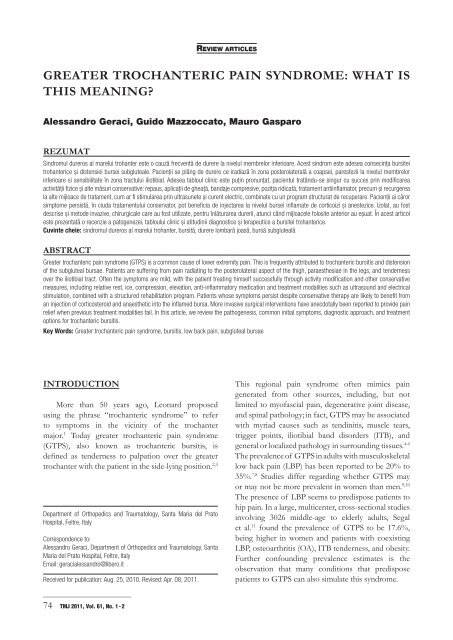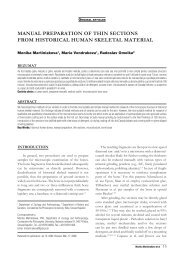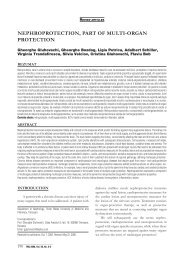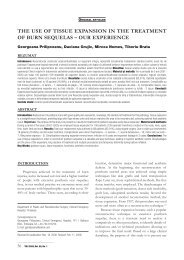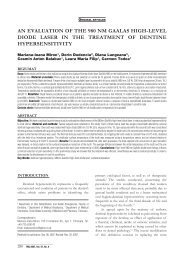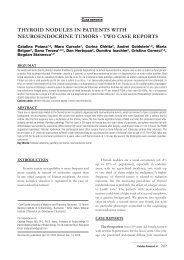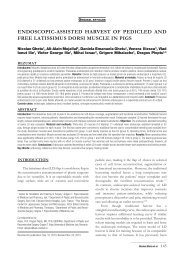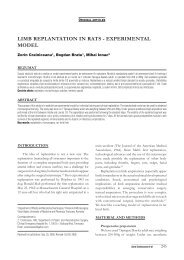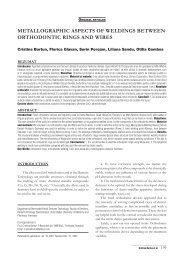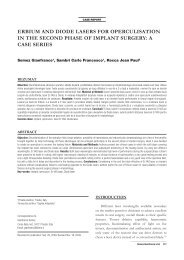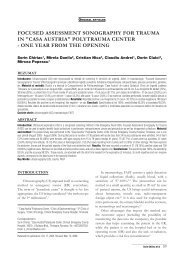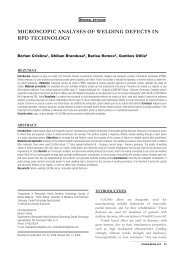greater trochanteric pain syndrome: what is this meaning?
greater trochanteric pain syndrome: what is this meaning?
greater trochanteric pain syndrome: what is this meaning?
Create successful ePaper yourself
Turn your PDF publications into a flip-book with our unique Google optimized e-Paper software.
_____________________________<br />
74 TMJ 2011, Vol. 61, No. 1 - 2<br />
REVIEW ARTICLES<br />
GREATER TROCHANTERIC PAIN SYNDROME: WHAT IS<br />
THIS MEANING?<br />
Alessandro Geraci, Guido Mazzoccato, Mauro Gasparo<br />
REZUMAT<br />
Sindromul dureros al marelui trohanter este o cauză frecventă de durere la nivelul membrelor inferioare. Acest sindrom este adesea consecinţa bursitei<br />
trohanterice şi d<strong>is</strong>tensiei bursei subgluteale. Pacienţii se plâng de durere ce iradiază în zona posterolaterală a coapsei, parestezii la nivelul membrelor<br />
inferioare si sensibilitate în zona tractului iliotibial. Adesea tabloul clinic este puţin pronunţat, pacientul tratându-se singur cu succes prin modificarea<br />
activităţii fizice şi alte măsuri conservative: repaus, aplicaţii de gheaţă, bandaje compresive, poziţia ridicată, tratament antiinflamator, precum şi recurgerea<br />
la alte mijloace de tratament, cum ar fi stimularea prin ultrasunete şi curent electric, combinate cu un program structurat de recuperare. Pacienţii ai căror<br />
simptome pers<strong>is</strong>tă, în ciuda tratamentului conservator, pot beneficia de injectarea la nivelul bursei inflamate de corticoizi şi anestezice. Izolat, au fost<br />
descr<strong>is</strong>e şi metode invazive, chirurgicale care au fost utilizate, pentru înlăturarea durerii, atunci când mijloacele folosite anterior au eşuat. În acest articol<br />
este prezentată o recenzie a patogenezei, tabloului clinic şi atitudinii diagnostice şi terapeutice a bursitei trohanterice.<br />
Cuvinte cheie: sindromul dureros al marelui trohanter, bursită, durere lombară joasă, bursă subgluteală<br />
ABSTRACT<br />
Greater <strong>trochanteric</strong> <strong>pain</strong> <strong>syndrome</strong> (GTPS) <strong>is</strong> a common cause of lower extremity <strong>pain</strong>. Th<strong>is</strong> <strong>is</strong> frequently attributed to <strong>trochanteric</strong> bursit<strong>is</strong> and d<strong>is</strong>tension<br />
of the subgluteal bursae. Patients are suffering from <strong>pain</strong> radiating to the posterolateral aspect of the thigh, paraesthesiae in the legs, and tenderness<br />
over the iliotibial tract. Often the symptoms are mild, with the patient treating himself successfully through activity modification and other conservative<br />
measures, including relative rest, ice, compression, elevation, anti-inflammatory medication and treatment modalities such as ultrasound and electrical<br />
stimulation, combined with a structured rehabilitation program. Patients whose symptoms pers<strong>is</strong>t despite conservative therapy are likely to benefit from<br />
an injection of corticosteroid and anaesthetic into the inflamed bursa. More invasive surgical interventions have anecdotally been reported to provide <strong>pain</strong><br />
relief when previous treatment modalities fail. In th<strong>is</strong> article, we review the pathogenes<strong>is</strong>, common initial symptoms, diagnostic approach, and treatment<br />
options for <strong>trochanteric</strong> bursit<strong>is</strong>.<br />
Key Words: Greater <strong>trochanteric</strong> <strong>pain</strong> <strong>syndrome</strong>, bursit<strong>is</strong>, low back <strong>pain</strong>, subgluteal bursae<br />
INTRODUCTION<br />
More than 50 years ago, Leonard proposed<br />
using the phrase “<strong>trochanteric</strong> <strong>syndrome</strong>” to refer<br />
to symptoms in the vicinity of the trochanter<br />
major. 1 Today <strong>greater</strong> <strong>trochanteric</strong> <strong>pain</strong> <strong>syndrome</strong><br />
(GTPS), also known as <strong>trochanteric</strong> bursit<strong>is</strong>, <strong>is</strong><br />
defined as tenderness to palpation over the <strong>greater</strong><br />
trochanter with the patient in the side-lying position. 2,3<br />
Department of Orthopedics and Traumatology, Santa Maria del Prato<br />
Hospital, Feltre, Italy<br />
Correspondence to:<br />
Alessandro Geraci, Department of Orthopedics and Traumatology, Santa<br />
Maria del Prato Hospital, Feltre, Italy<br />
Email: geracialessandro@libero.it<br />
Received for publication: Aug. 25, 2010. Rev<strong>is</strong>ed: Apr. 08, 2011.<br />
Th<strong>is</strong> regional <strong>pain</strong> <strong>syndrome</strong> often mimics <strong>pain</strong><br />
generated from other sources, including, but not<br />
limited to myofascial <strong>pain</strong>, degenerative joint d<strong>is</strong>ease,<br />
and spinal pathology; in fact, GTPS may be associated<br />
with myriad causes such as tendinit<strong>is</strong>, muscle tears,<br />
trigger points, iliotibial band d<strong>is</strong>orders (ITB), and<br />
general or localized pathology in surrounding t<strong>is</strong>sues. 4-6<br />
The prevalence of GTPS in adults with musculoskeletal<br />
low back <strong>pain</strong> (LBP) has been reported to be 20% to<br />
35%. 7,8 Studies differ regarding whether GTPS may<br />
or may not be more prevalent in women than men. 9,10<br />
The presence of LBP seems to pred<strong>is</strong>pose patients to<br />
hip <strong>pain</strong>. In a large, multicenter, cross-sectional studies<br />
involving 3026 middle-age to elderly adults, Segal<br />
et al. 11 found the prevalence of GTPS to be 17.6%,<br />
being higher in women and patients with coex<strong>is</strong>ting<br />
LBP, osteoarthrit<strong>is</strong> (OA), ITB tenderness, and obesity.<br />
Further confounding prevalence estimates <strong>is</strong> the<br />
observation that many conditions that pred<strong>is</strong>pose<br />
patients to GTPS can also simulate th<strong>is</strong> <strong>syndrome</strong>.
ANATOMY<br />
In the literature there have been described more<br />
than 20 bursae in the <strong>trochanteric</strong> region. 12 Three are<br />
certainly the most representative: the gluteus minimus<br />
bursa, he subgluteus maximus and subgluteus medius<br />
bursae. The gluteus minimus bursa lies above and<br />
slightly anterior to the proximal superior surface of the<br />
<strong>greater</strong> trochanter. The subgluteus medius bursa lies<br />
beneath the gluteus medius muscle, situated posterior<br />
and superior to the proximal edge of the <strong>greater</strong><br />
trochanter. The subgluteus maximus bursa lies beneath<br />
the converging fibers to the tensor fasciae latae and<br />
the gluteus maximus muscle and fascia as they join to<br />
Figure 1. (From AJR:1982, January 2004): Anatomy of<br />
<strong>trochanteric</strong> region. a = gluteus minimus muscle, b = gluteus<br />
medius muscle, c = subgluteus minimus bursa, d = subgluteus<br />
medius bursa, e = subgluteus maximus bursa, f = zona orbicular<strong>is</strong><br />
of hip joint capsule, g = superior neck recess of hip joint,<br />
h = inferior neck recess of hip joint, i = vastus lateral<strong>is</strong> muscle, k =<br />
iliotibial band.<br />
Table 1. Conditions associated with <strong>greater</strong> <strong>trochanteric</strong> <strong>pain</strong><br />
<strong>syndrome</strong>. 14-17<br />
Obesity<br />
Ipsilateral and/or contralateral hip arthrit<strong>is</strong><br />
Radiculopathy or other neurologic sequelae<br />
Repetitive activity<br />
Acute trauma<br />
Rheumatoid arthrit<strong>is</strong><br />
Chronic mechanical low-back <strong>pain</strong><br />
Leg length d<strong>is</strong>crepancy<br />
Lateral hip surgery<br />
Lumbar spine degenerative osteoarthrit<strong>is</strong><br />
Lumber spine degenerative d<strong>is</strong>k d<strong>is</strong>ease<br />
Post surgical lumbar d<strong>is</strong>k d<strong>is</strong>ease<br />
Fibromyalgia<br />
Iliotibial band (snapping hip) <strong>syndrome</strong><br />
Total hip arthroplasty<br />
Lower limb amputation<br />
form the iliotibial tract, and it separates the converging<br />
fibers from the <strong>greater</strong> trochanter and the origin of<br />
the vastus lateral<strong>is</strong>. It <strong>is</strong> lateral to the <strong>greater</strong> trochanter<br />
and <strong>is</strong> separated from the trochanter by the gluteus<br />
medius muscle (Fig. 1). The subgluteus maximus bursa<br />
<strong>is</strong> most frequently incriminated in GTPS. 13<br />
CAUSES AND PATHOGENESIS<br />
The causes of GTPS can be traumatic and<br />
nontraumatic. (Table 1) R<strong>is</strong>k factors are various<br />
and variously described, including age, female<br />
gender, ipsilateral ITB <strong>pain</strong>, knee OA, obesity,<br />
and LBP. 14,15 Overuse of the <strong>trochanteric</strong> bursa<br />
and or an inflammation of the bursa may cause<br />
<strong>trochanteric</strong> bursit<strong>is</strong>. Because <strong>trochanteric</strong> bursit<strong>is</strong><br />
can result from friction between the bursae and GT,<br />
bursal inflammation may result from either chronic<br />
microtrauma, regional muscle dysfunction, overuse<br />
or acute injury. 16,17 The main tendon of the gluteus<br />
medius muscle attaches to the postero-superior<br />
aspect of the GT, with the lateral tendon inserting<br />
into the lateral aspect. The gluteus minimus muscle<br />
attaches to the anterior facet of the GT. Consequently,<br />
inflammation and tears of either the gluteus medius<br />
or minimus muscles, or their tendinous insertions,<br />
from tension imposed by the ITB and/or frictional<br />
trauma from overuse, may result in GTPS. 18<br />
Specific etiologies of GTPS include repetitive<br />
activity, acute trauma, crystal deposition and<br />
infection, especially tuberculos<strong>is</strong>. 19,20 When an inciting<br />
event can be identified, the initial pathology usually<br />
_____________________________<br />
Alessandro Geraci et al 75
Table 2. Clinical features of <strong>greater</strong> <strong>trochanteric</strong> <strong>pain</strong> <strong>syndrome</strong>. 23 Table 3. Criteria for Diagnos<strong>is</strong> of Great Trochanteric Pain<br />
Syndrome. 25<br />
Pain on lateral aspect of hip over <strong>greater</strong> trochanter.<br />
Pain may radiate down lateral aspect of thigh but not below<br />
knee.<br />
External rotation of hip with abduction may exacerbate the<br />
<strong>pain</strong>.<br />
Pain may be exacerbated by physical activity (walking,<br />
climbing stairs, running)<br />
More common in women than men.<br />
Peak incidence 40–60 years of age but can occur in adult<br />
of any age.<br />
Sleep d<strong>is</strong>turbance may be common when patient turns to<br />
lie on affected side.<br />
Classic feature <strong>is</strong> point tenderness on palpation directly<br />
over <strong>greater</strong> trochanter which reproduces the <strong>pain</strong>.<br />
occurs at the tendinous attachments to the GT, with<br />
secondary involvement of adjacent bursae. Acute<br />
trauma includes contusions from falls, contact sports,<br />
and other sources of impact. Repetitive trauma<br />
includes bursal irritation resulting from friction by<br />
the iliotibial band (ITB), which <strong>is</strong> an extension of the<br />
tensor fascia lata muscle. Such repetitive, cumulative<br />
irritation often occurs in runners but can also be<br />
seen in less active individuals. Other pred<strong>is</strong>posing<br />
factors include a leg-length d<strong>is</strong>crepancy and lateral<br />
hip surgery. 21,22<br />
SYMPTOMS<br />
GTPS <strong>is</strong> characterized by chronic, intermittent<br />
aching <strong>pain</strong> at the <strong>greater</strong> <strong>trochanteric</strong> region at the<br />
lateral hip. 23 (Table 2) The <strong>pain</strong> can radiate into the<br />
lower buttocks and the lateral aspect of the thigh,<br />
but it rarely extends into the posterior aspect of<br />
the thigh or below the knee. Occasionally, patients<br />
experience numbness in the upper thigh with no<br />
specific dermatomal pattern. Patients report <strong>pain</strong> from<br />
<strong>greater</strong> <strong>trochanteric</strong> bursit<strong>is</strong> with a variety of activities<br />
or movements. The <strong>pain</strong> <strong>is</strong> exacerbated by lying on<br />
the affected side, with prolonged standing position,<br />
sitting with the affected leg crossed and with climbing<br />
stairs, running or other high impact activities. Any<br />
movement of the affected hip can reproduce the <strong>pain</strong><br />
of <strong>greater</strong> <strong>trochanteric</strong> bursit<strong>is</strong>, but external rotation<br />
and abduction of the hip are most common.<br />
Pain extending to the groin or down the lateral<br />
thigh that mimics lumbar d<strong>is</strong>k herniation may be<br />
reported by some individuals. 24 The most common<br />
d<strong>is</strong>ability <strong>is</strong> exerc<strong>is</strong>e limitations to include walking. It <strong>is</strong><br />
also associated with broken sleep patterns secondary<br />
to the inability to lie on the affected side because of<br />
_____________________________<br />
76 TMJ 2011, Vol. 61, No. 1 - 2<br />
Lateral hip <strong>pain</strong><br />
Pinpoint tenderness over the <strong>greater</strong> trochanter area<br />
D<strong>is</strong>tinct tenderness about the <strong>greater</strong> trochanter<br />
Pain at the extreme of rotation, abduction, or adduction<br />
Pain on hip abduction against res<strong>is</strong>tance<br />
Tender over gluteus medius muscle<br />
Positive Patrick-Fabere’s test<br />
Pseudoradiculopathy (<strong>pain</strong> radiating down the lateral<br />
aspect of the thigh)<br />
<strong>pain</strong>. In addition, a large number of patients have<br />
bilateral bursit<strong>is</strong>, further sleep interrupting patterns.<br />
PHYSICAL EXAMINATION<br />
Structuring the examination by beginning centrally<br />
and working out from the hip joint helps to identify<br />
the contributing factors of the patient’s complaint. 25<br />
(Table 3). Pinpoint tenderness over the <strong>greater</strong> trochanter<br />
area <strong>is</strong> the hallmark physical finding in all symptomatic<br />
patients. Tenderness may extend into the lower buttock<br />
and lateral thigh but not to a significant degree.<br />
While the patient <strong>is</strong> standing, palpate the lateral<br />
hip area in a cephalic direction beginning below the<br />
<strong>greater</strong> trochanter eminence until the area of maximal<br />
tenderness <strong>is</strong> identified (“jump sign”). 26 Pain can also<br />
be reproduced by res<strong>is</strong>ted abduction and external<br />
rotation. To perform res<strong>is</strong>ted abduction, place the<br />
patient in a sitting position with knees flexed. The<br />
examiner places h<strong>is</strong> or her hand on the lateral aspect of<br />
the upper thigh and instructs the patient to move the<br />
thigh laterally against the res<strong>is</strong>tance. External rotation<br />
of the hip <strong>is</strong> obtained by placing the patient in a sitting<br />
position with the knees flexed and adducting the lower<br />
leg (shin).<br />
Pain on flexion and extension of the hip <strong>is</strong> indicative<br />
of intra-articular hip d<strong>is</strong>ease and not usually of a <strong>greater</strong><br />
<strong>trochanteric</strong> bursit<strong>is</strong>. 27 Objective swelling <strong>is</strong> rare because<br />
of the bulky muscles overlying the deep structures of<br />
the trochanter bursa. More than half of the patients<br />
with GPTS have <strong>pain</strong> on Patrick-Fabere testing of the<br />
affected hip while flexing the ipsilateral knee. 28 In most<br />
patients with limitation of range of motion of the<br />
affected hip, the underlying cause <strong>is</strong> arthrit<strong>is</strong>.<br />
Other physical findings such as limited lumbar<br />
range of motion and muscle atrophy may reveal other<br />
associated conditions such as lumbar spondylos<strong>is</strong> and<br />
nerve root compression. In severe cases of bursit<strong>is</strong><br />
the presence of soft t<strong>is</strong>sue crepitus can be found. 29<br />
(Table 4)
DIAGNOSTIC STUDIES<br />
No specific radiographic findings are of diagnostic<br />
value for a <strong>trochanteric</strong> bursit<strong>is</strong>. 30 X-Rays of the hip,<br />
pelv<strong>is</strong>, and lower spine may show evidence of one or<br />
more of the associated musculoskeletal conditions.<br />
On occasion, calcifications around the <strong>greater</strong><br />
trochanter may be seen (approximately 40% of<br />
patients with <strong>greater</strong> <strong>trochanteric</strong> bursit<strong>is</strong>). 31 (Fig. 2)<br />
These calcifications varies in size and shape from a<br />
few millimeters to 3 to 4 cm in diameter. They appear<br />
as linear or small, rounded masses that are separated<br />
or grouped together. Irregularities can also be seen<br />
on the surface of the <strong>greater</strong> trochanter. Often<br />
on CT the d<strong>is</strong>tended bursa <strong>is</strong> noted as a septated<br />
low attenuation lesion at the site of insertion of<br />
the gluteus medius and minimus muscles on the<br />
<strong>greater</strong> trochanter. 32 (Fig. 3) Bone scans may show<br />
increased uptake in the area of the <strong>greater</strong> trochanter,<br />
and magnetic resonance imaging (MRI) scans or<br />
sonography may show a high-intensity signal in the<br />
<strong>greater</strong> trochanter area, but all of these findings may<br />
not always have actual clinical significance and vice<br />
versa. The MRI appearance of tendinos<strong>is</strong> and tear<br />
of the abductor tendons of the hip <strong>is</strong> the same as<br />
in other locations and includes alterations in tendon<br />
Table 4. Common tests utilized in evaluation of lateral hip <strong>pain</strong>. 29<br />
signal and caliber. 33 Partial thickness and complete<br />
tears of the gluteus minimus or medius tendons<br />
are v<strong>is</strong>ible with MRI. (Figs. 4, 5) Muscle atrophy <strong>is</strong><br />
frequent with chronic large tears. 34 If a larger field<br />
of view <strong>is</strong> utilized to incorporate both hips, tendon<br />
v<strong>is</strong>ualization <strong>is</strong> often limited and secondary signs<br />
become critical in detecting abductor tendon tears.<br />
The most frequently encountered secondary sign <strong>is</strong> a<br />
<strong>greater</strong> than 1 cm in diameter localized area of high<br />
signal superior to the <strong>greater</strong> trochanter. 33,34 (Fig. 6)<br />
TREATMENTS<br />
Initially, treatment of <strong>trochanteric</strong> bursit<strong>is</strong> involves<br />
ice, over-the-counter nonsteroidal anti-inflammatory<br />
drugs (NSAIDs) to reduce <strong>pain</strong> and inflammation,<br />
and activity modification (e.g., avoiding stairs, reducing<br />
repetitive sit-to-stand movements). 35 The individual<br />
<strong>is</strong> instructed to avoid placing direct pressure on the<br />
bursa by sleeping on the unaffected side and using<br />
a pillow between the knees (adductor pillow) to<br />
minimize indirect bursal compression from overlying<br />
tight musculature. Patients whose symptoms pers<strong>is</strong>t<br />
despite conservative therapy are likely to benefit<br />
from an injection of 24 mg betamethasone and 1%<br />
lidocaine (or equivalent) into the inflamed bursa. Th<strong>is</strong><br />
- Point tenderness at <strong>greater</strong> trochanter: The patient <strong>is</strong> in standing or supine position. Point tenderness <strong>is</strong> elicited at the ipsilateral<br />
<strong>greater</strong> trochanter. If lateral hip <strong>pain</strong> <strong>is</strong> elicited Greater <strong>trochanteric</strong> <strong>pain</strong> <strong>syndrome</strong> may be present.<br />
- Res<strong>is</strong>ted internal rotation test: The patient <strong>is</strong> in the supine position and the affected hip at 45° flexion and maximal external<br />
rotation. The test result <strong>is</strong> as positive if the patient indicates replication of symptoms over the <strong>greater</strong> trochanter on res<strong>is</strong>ted active<br />
internal rotation. If lateral hip <strong>pain</strong> <strong>is</strong> elicited, Greater <strong>trochanteric</strong> <strong>pain</strong> <strong>syndrome</strong> may be present.<br />
- Res<strong>is</strong>ted active abduction: The patient <strong>is</strong> in the supine position with the affected hip at 45° abduction. A positive test results if<br />
the patient indicates replication of symptoms over the <strong>greater</strong> trochanter on res<strong>is</strong>ted active abduction. If lateral hip <strong>pain</strong> <strong>is</strong> elicited,<br />
Greater <strong>trochanteric</strong> <strong>pain</strong> <strong>syndrome</strong> may be present.<br />
- Ober’s testing: The patient <strong>is</strong> in the lateral position with the unaffected side down. The affected leg <strong>is</strong> passively extended and<br />
lowered to the table. If lateral hip <strong>pain</strong> <strong>is</strong> elicited or iliotibial band tightness, iliotibial band <strong>syndrome</strong> may be present.<br />
- Patrick (Fabere) testing: The patient <strong>is</strong> in the supine position with the affected leg flexed, abducted, and externally rotated with<br />
the ankle resting on the thigh of the unaffected leg. One hand <strong>is</strong> placed on the anterior superior iliac spine of the unaffected side,<br />
while the other hand applies downward pressure on the affected leg. The test result <strong>is</strong> positive if the patient indicates <strong>pain</strong> about the<br />
affected hip. Pain may also be elicited at or about the sacroiliac joint indicating sacroiliac joint dysfunction.<br />
- Gillet’s test: The patient stands with the feet apart and the clinician places one thumb on the posterior superior iliac spine (PSIS) of<br />
the side to be tested and the other thumb on the sacral base. The patient flexes the hip and knee to 90° on the side being tested.<br />
The test result <strong>is</strong> positive if the PSIS moves superiorly, Sacroiliac joint dysfunction may be present.<br />
- Thomas test: The patient lies supine and flexes the unaffected hip, holding the knee to the chest. The test result <strong>is</strong> positive if the<br />
patient’s other leg will r<strong>is</strong>e off the table, Sacroiliac joint dysfunction may be present.<br />
- Trendelenburg’s testing: The patient stands on the affected leg and ra<strong>is</strong>es the unaffected leg to 30–90°. A pelvic tilt below the<br />
level of the stance side indicates a positive test, Gluteus medius muscle dysfunction may be present.<br />
- Straight leg ra<strong>is</strong>e: The patient lies supine and the affected extremity ra<strong>is</strong>ed straight up. The test result <strong>is</strong> positive if the patient<br />
complains of <strong>pain</strong> in the extremity (not the back) typically in a specific nerve root d<strong>is</strong>tribution, Lumbar radiculopathy may be present.<br />
_____________________________<br />
Alessandro Geraci et al 77
Figure 2. X-rays of the hip of patient with Great Trochanteric Pain<br />
Syndrome, demonstrating irregularity of the <strong>greater</strong> trochanter<br />
and calcification in the region of subgluteus medius bursa.<br />
Figure 3. Fluid collections inside the bursae of both hip joints,<br />
hyperintense on T2WI.<br />
therapy has been shown to provide <strong>pain</strong> relief, with<br />
response rates ranging from 60% to 100%. 36-38 There<br />
<strong>is</strong> no conclusive evidence that these injections are<br />
effective, although small observational studies suggest<br />
that injections with corticosteroids are effective in the<br />
_____________________________<br />
78 TMJ 2011, Vol. 61, No. 1 - 2<br />
Figure 4. Magnetic resonance image, showing <strong>trochanteric</strong><br />
bursit<strong>is</strong> with fluid signal around the <strong>greater</strong> trochanter.<br />
short-term follow-up. 39,40 The purpose of rehabilitation<br />
for GPTS <strong>is</strong> to restore normal flexibility, strength,<br />
and functional mobility with a mobile, <strong>pain</strong>less hip;<br />
Transcutaneous electrical neuromuscular stimulation<br />
(TENS), ionophores<strong>is</strong> and therapeutic ultrasound<br />
may be helpful in some cases for <strong>pain</strong> relief. 41 The<br />
physical therap<strong>is</strong>t focuses on stretching exerc<strong>is</strong>es<br />
to improve hip range of motion, especially external<br />
rotation, and to increase the extensibility of adjacent<br />
tight soft t<strong>is</strong>sues (e.g., gluteus medius, iliotibial band,<br />
tensor fascia lata) that may be causing friction on the<br />
inflamed bursa. Soft t<strong>is</strong>sue mobilization and myofascial<br />
release may help to lengthen tight musculature of the<br />
tensor fascia lata and iliotibial band. 42 Strengthening<br />
exerc<strong>is</strong>es can be progressed as tolerated, with<br />
emphas<strong>is</strong> on hip abductor, extensor, and external<br />
rotator muscles, to enhance the return to function. If<br />
the individual has developed an altered gait pattern to<br />
reduce <strong>pain</strong> (antialgic gait pattern), gait training may<br />
be necessary to restore normal movement patterns<br />
with ambulation. In severe cases, temporary use of<br />
an ass<strong>is</strong>tive device (cane, crutch) may be necessary.<br />
In patients who fail conservative treatment, surgical<br />
intervention has been advocated. Several types of<br />
surgical procedures are available to treat <strong>trochanteric</strong><br />
bursit<strong>is</strong>. 43 The primary goal of all procedures<br />
designed to treat th<strong>is</strong> condition <strong>is</strong> to remove the<br />
thickened bursa, to remove any bone spurs that may<br />
have formed on the <strong>greater</strong> trochanter, and to relax<br />
the large tendon of the gluteus maximus. The open<br />
surgical procedure cons<strong>is</strong>ted of simple longitudinal<br />
release of the iliotibial band over the <strong>greater</strong> trochanter<br />
and exc<strong>is</strong>ion of the subgluteal bursa. Dumbar et al. 40<br />
reported that bursectomy and Z-lengthening has been<br />
shown to be an effective and long-term operative
solution for the treatment of refractory <strong>trochanteric</strong><br />
bursit<strong>is</strong> when conservative measures have failed.<br />
The recalcitrant TB can sometimes be addressed<br />
with arthroscopic bursectomy and/or ITB release. The<br />
use of arthroscopy to treat recalcitrant <strong>trochanteric</strong><br />
bursit<strong>is</strong> <strong>is</strong> reported and its role in treating th<strong>is</strong> common<br />
clinical entity <strong>is</strong> d<strong>is</strong>cussed. Fox et al. 41 showed that<br />
arthroscopically performed <strong>trochanteric</strong> bursectomy<br />
<strong>is</strong> a minimally invasive technique that appears to be<br />
both safe and effective for treating recalcitrant <strong>pain</strong><br />
<strong>syndrome</strong>s. Farr et al. 44 believe that the iliotibial band<br />
must be addressed and <strong>is</strong> the main cause of <strong>pain</strong>,<br />
inflammation, and <strong>trochanteric</strong> impingement leading<br />
to the development of bursit<strong>is</strong> and report a new<br />
technique for arthroscopic <strong>trochanteric</strong> bursectomy<br />
with iliotibial band release.<br />
Septic bursit<strong>is</strong> <strong>is</strong> unusual in the hip bursa but does<br />
occur. The bursal fluid can be examined in the laboratory<br />
for the microorgan<strong>is</strong>ms causing the infection. 45 Septic<br />
bursit<strong>is</strong> <strong>is</strong> caused by the Staphylococcus aureus. Th<strong>is</strong> <strong>is</strong><br />
confirmed by antibiogram from the fluid in the bursa<br />
and requires antibiotic treatment. When a patient has<br />
such a serious infection, there may be underlying causes.<br />
There could be und<strong>is</strong>covered diabetes, or an inefficient<br />
immune system caused by human immunodeficiency<br />
virus infection (HIV). 46 Repeated aspiration of the<br />
infected fluid may be required. Surgical drainage and<br />
removal of the infected bursa may also be necessary. 47<br />
CONCLUSIONS<br />
Trochanteric bursit<strong>is</strong> <strong>is</strong> a common cause of hip<br />
and leg <strong>pain</strong>. Hip <strong>pain</strong> brings patients to health care<br />
providers, including both primary care and specialty<br />
providers. Causes of hip <strong>pain</strong> often are attributed to<br />
d<strong>is</strong>orders in the lower back or hip joint. R<strong>is</strong>k factors for<br />
th<strong>is</strong> d<strong>is</strong>order include obesity, female gender, overuse<br />
and altered gait mechanics.<br />
MR imaging and plain radiographs provide<br />
detailed information about the anatomy of tendinous<br />
attachments of the abductor muscles and the bursal<br />
complex of the <strong>greater</strong> trochanter.<br />
In most cases the d<strong>is</strong>order <strong>is</strong> self-limiting, with<br />
treatment cons<strong>is</strong>ting of conservative measures such<br />
as behaviour modification, physical therapy, weight<br />
loss, and nonsteroidal anti-inflammatory drugs. When<br />
these interventions fail, bursa injections with local<br />
admin<strong>is</strong>tration of a mixture of corticosteroid and<br />
local anaesthetic have been shown to provide good<br />
<strong>pain</strong> relief. A specific and goal-directed rehabilitation<br />
program often seems quite reasonable. Physical<br />
therapy can be incorporated to teach the patient a<br />
home exerc<strong>is</strong>e program, emphasizing stretching of<br />
the ITB, tensor fascia lata (TFL), external hip rotators,<br />
quadriceps, and hip flexors.<br />
Arthroscopic bursectomy appears to be an<br />
effective option for recalcitrant <strong>trochanteric</strong> bursit<strong>is</strong><br />
and <strong>is</strong> a viable alternative to open bursectomy. Greater<br />
trochanteic bursit<strong>is</strong> <strong>is</strong> often underdiagnosed as a cause<br />
of hip <strong>pain</strong> despite its character<strong>is</strong>tic symptoms of<br />
diffuse <strong>pain</strong> in the buttocks and lateral thigh. Because<br />
<strong>greater</strong> <strong>trochanteric</strong> bursit<strong>is</strong> <strong>is</strong> so common and fairly<br />
responsive to treatment, it <strong>is</strong> important for health care<br />
providers to include th<strong>is</strong> diagnos<strong>is</strong> in their differential<br />
diagnos<strong>is</strong> when evaluating hip <strong>pain</strong>.<br />
ACKNOWLEDGEMENTS<br />
It <strong>is</strong> a great pleasure to thank our superv<strong>is</strong>or, Dr.<br />
Renzo Bianchi.<br />
REFERENCES<br />
1. Leonard MH. Trochanteric <strong>syndrome</strong>; calcareous and noncalcareous<br />
tendonit<strong>is</strong> and bursit<strong>is</strong> about the trochanter major. J Am Med Assoc<br />
1958;168:175–7.<br />
2. Shapira D, Nahir M, Shcharf Y. Trochanteric bursit<strong>is</strong>: a common<br />
clinical problem. Arch Phys Med Rehabil 1986;67:815-7.<br />
3. Adkins SB, Figler RA. Hip <strong>pain</strong> in athletes. American Family Physician<br />
2000;61(7):2109-18.<br />
4. Shbeeb MI, Matteson EL. Trochanteric bursit<strong>is</strong> (<strong>greater</strong> trochanter<br />
<strong>pain</strong> <strong>syndrome</strong>). Mayo Clin Proc 1996;71:565-9.<br />
5. Tortolani PJ, Carbone JJ, Quartararo LG. Greater <strong>trochanteric</strong> <strong>pain</strong><br />
<strong>syndrome</strong> in patients referred to orthopedic spine special<strong>is</strong>ts. Spine<br />
J 2002;2:251–4.<br />
6. Alvarez-Nemegyei J, Canoso JJ. Evidence-based soft t<strong>is</strong>sue rheumatology:<br />
III: <strong>trochanteric</strong> bursit<strong>is</strong>. J Clin Rheumatol 2004;10:123–4.<br />
7. Swezey RL. Pseudo-radiculopathy in subacute <strong>trochanteric</strong> bursit<strong>is</strong><br />
of the subgluteus maximus bursa. Arch Phys Med Rehabil<br />
1976;57:387-90.<br />
8. Sayegh F, Potoupn<strong>is</strong> M, Kapetanos G. Greater trochanter bursit<strong>is</strong> <strong>pain</strong><br />
<strong>syndrome</strong> in females with chronic low back <strong>pain</strong> and sciatica. Acta<br />
Orthop Belg 2004;70:423–428..<br />
9. Collee G, Dijkmans BA, Vandenbroucke JP, et al. A clinical<br />
epidemiological study in low back <strong>pain</strong>. Description of two clinical<br />
<strong>syndrome</strong>s. Br J Rheumatol 1990;29:354-7.<br />
10. Chr<strong>is</strong>tmas C, Crespo CJ, Franckowiak SC, et al. How common <strong>is</strong> hip<br />
<strong>pain</strong> among older adults? Results from the Third National Health<br />
and Nutrition Examination Survey. J Fam Pract 2002;51:345–8.<br />
11. Segal NA, Felson DT, Torner J, et al. Greater <strong>trochanteric</strong> <strong>pain</strong><br />
<strong>syndrome</strong>: epidemiology and associated factors. Arch Phys Med<br />
Rehabil 2007;88(8):988-92.<br />
12. Dunn T, Heller CA, McCarthy SW, Dos Remedios C. Anatomical study<br />
of the “<strong>trochanteric</strong> bursa.” Clin Anat 2003;16:233–40.<br />
13. Woodley SJ, Mercer SR, Nicholson HD. Morphology of the bursae<br />
associated with the <strong>greater</strong> trochanter of the femur. J Bone Joint<br />
Surg Am 2008;90:284–94.<br />
14. Little H. Trochanteric bursit<strong>is</strong>: a common cause of pelvic girdle <strong>pain</strong>.<br />
Can Med Assoc J 1979;120:456–8.<br />
15. Schapira D, Nahir M, Scharf Y. Trochanteric bursit<strong>is</strong>: a common clinical<br />
problem. Arch Phys Med Rehabil 1986;67:815–17.<br />
16. Cohen SP, Raja SN. Pathogenes<strong>is</strong>, diagnos<strong>is</strong>, and treatment of lumbar<br />
zygapophysial (facet) joint <strong>pain</strong>. Anesthesiology 2007;106:591–614.<br />
17. Johnston CA, Wiley JP, Lindsay DM, W<strong>is</strong>eman DA. Iliopsoas bursit<strong>is</strong><br />
and tendinit<strong>is</strong>. A review. Sports Med 1998;25:271–83.<br />
_____________________________<br />
Alessandro Geraci et al 79
18. Pfirrmann CW, Chung CB, Theumann NH, et al. Greater trochanter of<br />
the hip: attachment of the abductor mechan<strong>is</strong>m and a complex of<br />
three bursae–MR imaging and MR bursography in cadavers and MR<br />
imaging in asymptomatic volunteers. Radiology 2001;221:469–77.<br />
19. Abdelwahab IF, Bianchi S, Martinoli C, et al. Atypical extraspinal<br />
musculoskeletal tuberculos<strong>is</strong> in immunocompetent patients: part<br />
II, tuberculous myosit<strong>is</strong>, tuberculous bursit<strong>is</strong>, and tuberculous<br />
tenosynovites. Can Assoc Radiol J 2006;57:278–86.<br />
20. Butcher JD, Salzman KL, Lillegard WA. Lower extremity bursit<strong>is</strong>. Am<br />
Fam Physician 1996;53:2317–24.<br />
21. Jones DL, Erhard RE. Diagnos<strong>is</strong> of <strong>trochanteric</strong> bursit<strong>is</strong> versus femoral<br />
neck stress fracture. Phys Ther 1997; 77:58-67.<br />
22. Silva F, Adams T, Feinstein J, et al. Trochanteric bursit<strong>is</strong>: refuting the<br />
myth of inflammation. J Clin Rheumatol. 2008;14(2):82-6.<br />
23. Lievense A, Bierma-Zeinstra S, Schouten B, et al. Prognos<strong>is</strong><br />
of <strong>trochanteric</strong> <strong>pain</strong> in primary care. Br J Gen Pract.<br />
2005;55(512):199-204.<br />
24. Tibor LM, Sekiya JK. Differential diagnos<strong>is</strong> of <strong>pain</strong> around the hip<br />
joint. Arthroscopy 2008;24(12):1407-21.<br />
25. Steinberg JG, Seybold EA. Hip and Pelv<strong>is</strong>. In: Steinberg GG, Akins CM,<br />
Baran DT, eds. Orthopaedic in Primary Care, 3rd ed. Baltimore,<br />
Md: Lippincott, Williams & Wilkins; 1998:171-203.<br />
26. Rowand M, Chambl<strong>is</strong>s ML, Mackler L. Clinical inquiries. How should<br />
you treat <strong>trochanteric</strong> bursit<strong>is</strong>? J Fam Pract. 2009;58(9):494-500.<br />
27. Lequesne M. From “periarthrit<strong>is</strong>” to hip “rotator cuff ” tears.<br />
Trochanteric tendinobursit<strong>is</strong>. Joint Bone Spine. 2006;73:344–348.<br />
28. Anderson BC. Office Orthopedics for Primary care: Diagnos<strong>is</strong> and<br />
Treatment, 2nd edition, WB Saunders, Philadelphia 1999.<br />
29. Adkins SB 3rd, Figler RA. Hip <strong>pain</strong> in athletes. Am Fam Physician<br />
2000.1;61(7):2109-18.<br />
30. Berqu<strong>is</strong>t TH, Bender CE, Maus TP, et al. Pseudobursae: a useful<br />
finding in patients with <strong>pain</strong>ful hip arthroplasty. Am J Roentgenol<br />
1987.148(1):103-6.<br />
31. Crevenna R, Kéilani M, Wiesinger G, et al. Calcific <strong>trochanteric</strong><br />
bursit<strong>is</strong>: resolution of calcifications and clinical rem<strong>is</strong>sion with<br />
non-invasive treatment. A case report. Wien Klin Wochenschr<br />
2002;114(8-9):345-8.<br />
32. Varma DG, Parihar A, Richli WR. CT appearance of the d<strong>is</strong>tended<br />
<strong>trochanteric</strong> bursa. J Comput Ass<strong>is</strong>t Tomogr 1993;17(1):141-3.<br />
_____________________________<br />
80 TMJ 2011, Vol. 61, No. 1 - 2<br />
33. Kong A, Van der Vliet A, Zadow S. MRI and US of gluteal<br />
tendinopathy in <strong>greater</strong> <strong>trochanteric</strong> <strong>pain</strong> <strong>syndrome</strong>. Eur Radiol<br />
2007;17(7):1772-83.<br />
34. Blankenbaker DG, Ullrick SR, Dav<strong>is</strong> KW. Correlation of MRI findings<br />
with clinical findings of <strong>trochanteric</strong> <strong>pain</strong> <strong>syndrome</strong>. Skeletal Radiol<br />
2008;37(10):903-9.<br />
35. Cohen SP. Sacroiliac joint <strong>pain</strong>: a comprehensive review of anatomy,<br />
diagnos<strong>is</strong>, and treatment. Anesth Analg 2005;101:1440–53.<br />
36. Wittich CM, Ficalora RD, Mason TG, Beckman TJ. Musculoskeletal<br />
injection. Mayo Clin Proc 2009;84(9):831-6.<br />
37. Shbeeb MI, O’Duffy JD, Michet CJ Jr, et al. Evaluation of<br />
glucocorticosteroid injection for the treatment of <strong>trochanteric</strong><br />
bursit<strong>is</strong>. J Rheumatol 1996;23:2104–6.<br />
38. Brinks A, van Rijn RM, Bohnen AM, et al. Effect of corticosteroid<br />
injection for trochanter <strong>pain</strong> <strong>syndrome</strong>: design of a random<strong>is</strong>ed clinical<br />
trial in general practice. BMC Musculoskelet D<strong>is</strong>ord 2007;19;8:95.<br />
39. VanWye WR. Patient screening by a physical therap<strong>is</strong>t for<br />
nonmusculoskeletal hip <strong>pain</strong>. Phys Ther 2009;89(3):248-56.<br />
40. Dunbar J., Craig R. Bursectomy and Z-lenghthening for refractory<br />
<strong>trochanteric</strong> bursit<strong>is</strong>. J Bone Joint Surg 2006; 88(B):312.<br />
41. Fox JL. The role of arthroscopic bursectomy in the treatment of<br />
<strong>trochanteric</strong> bursit<strong>is</strong>. Arthroscopy 2002;18(7):E34.<br />
42. Rompe JD, Segal NA, Cacchio A, et al. Home training, local<br />
corticosteroid injection, or radial shock wave therapy for <strong>greater</strong><br />
trochanter <strong>pain</strong> sindrome. Am J Sports Med 2009;37(10):1981-90.<br />
43. Williams BS, Cohen SP. Greater <strong>trochanteric</strong> <strong>pain</strong> <strong>syndrome</strong>: a<br />
review of anatomy, diagnos<strong>is</strong> and treatment. Anesth Analg<br />
2009;108(5):1662-70.<br />
44. Farr D, Selesnik H, Janecki C, Cordas D. Arthroscopic bursectomy with<br />
concomitant iliotibial band release for the treatment of recalcitrant<br />
<strong>trochanteric</strong> bursit<strong>is</strong>. Arthroscopy 2007;23(8):905.E1-5.<br />
45. Zimmermann B, Mikolich DJ, Ho G Jr. Septic bursit<strong>is</strong>. Semin Arthrit<strong>is</strong><br />
Rheum 1995;24:391.<br />
46. Soderqu<strong>is</strong>t B, Hedstrom SA. Pred<strong>is</strong>posing factors, bacteriology and<br />
antibiotic therapy in 35 cases of septic bursit<strong>is</strong>. Scand J Infect D<strong>is</strong><br />
1986;18(4):305-11.<br />
47. Craig RA, Jones DP, Oakley Ap, et al. Iliotibial band Z-lengthening<br />
for refractory <strong>trochanteric</strong> bursit<strong>is</strong> (<strong>greater</strong> <strong>trochanteric</strong> <strong>pain</strong><br />
<strong>syndrome</strong>). ANZ J Surg 2007;77:996-8.


